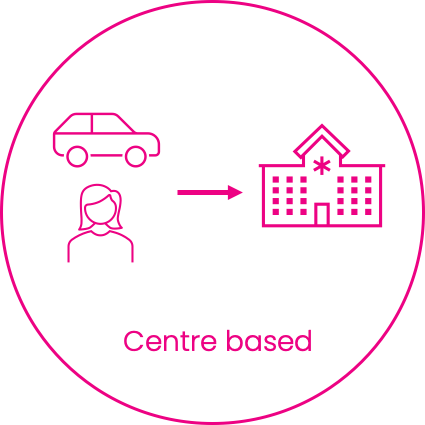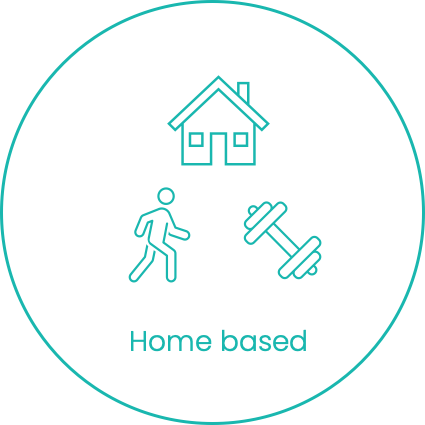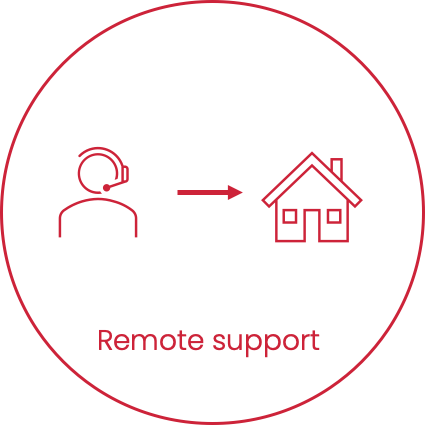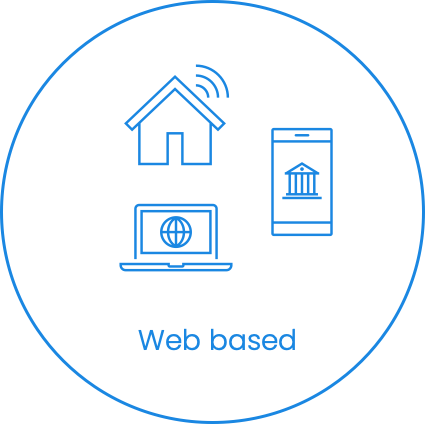
MODELS OF REHABILITATION
Depending on where you live, rehabilitation may be available to you in more than one format. This section describes some of the common features of different models of rehabilitation, including their potential advantages and disadvantages. Discuss the available options with your healthcare professional to determine which may be the best fit for your individual circumstances.

This is the most common form of rehabilitation, conducted in hospital outpatient departments or community centres. Rehabilitation is typically completed on-site in small groups of people with similar lung conditions.
It is traditional practice to refer individuals with COPD to centre-based pulmonary rehabilitation (PR) programs. However, these may not always be suitable or feasible for the individual for various reasons ranging from accessibility to work schedules or other health conditions that deem group exercise unadvisable.
Other models of rehabilitation are described below. If you are wanting to consider such alternative models, speak with a member of your healthcare team about their suitability and availability to you.

This form of rehabilitation involves completing exercises at home. Baseline assessments are commonly completed in a supervised outpatient department, however ongoing exercise is typically completed at home without supervision. Some programs may involve an initial home visit by a healthcare professional and some may provide a temporary loan of basic exercise equipment.
Home based rehabilitation should be individualised to your specific needs, including appropriate options for exercise, education and goal setting. Referrals to other health professionals may be organised if needed. Home based programs are often completed with a final re-assessment at the original outpatient department where you commenced.
Information for healthcare professionals regarding the design and delivery of home based rehabilitation programs can be found at homeBase Pulmonary Rehab.

This form of rehabilitation is commonly referred to as ‘tele-rehab’. Exercises are performed in the home setting but under the remote supervision of a healthcare professional.
Tele-rehabilitation has emerged as an increasingly common model of care during the COVID-19 pandemic due to its ability to overcome transmission reduction restrictions related to face-to-face group gatherings.
Tele-rehabilitation has similar components to centre-based programs, with modifications made for reduced patient contact. An initial assessment and individualised exercise program is prescribed over a video-conference call. Weekly exercise sessions might be supervised over set real-time video-conference calls, and further telehealth contact will review the patient’s progress and provide health coaching. Education related to disease knowledge and self-management is also delivered throughout the program. The program concludes with final assessments carried out via telehealth.

This form of rehabilitation involves self-guided, unsupervised exercise in the home setting. Education materials may be supplied to progress through in an independent manner.
Online Rehabilitation may comprise a standard (or generic) set of weekly exercises to select and complete as well as accompanying education material that can be completed at a time and location of your choosing. Some programs may allow opportunities for interaction with other participants completing similar programs, or healthcare professionals or online support groups.
This model of rehabilitation may suit people who are highly self-motivated, those who are comfortable using technology and/or people who may not be available to undertake rehabilitation on the days/times when other group programs may be offered (for example, if you still maintain employment). Some basic exercise equipment may need to be sourced.
Discuss your preferences for rehabilitation with your healthcare team: alternative options might be available
Other health services
At times, your healthcare team may refer you to another rehabilitation service if pulmonary rehabilitation (PR) is not the most suitable option at the commencement of rehabilitation. For example, a referral to a:
- Post-acute care physiotherapy or occupational therapy service that provides transitional (short-term) therapy in your home following hospital discharge;
- Community centre physiotherapy service to address focal issues. For example, aggravated back pain due to increased coughing that is a barrier to PR exercise, or;
- Gym program for high-level exercise training.